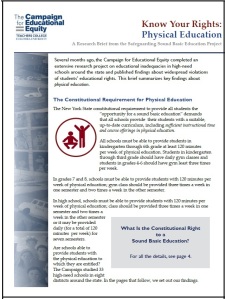Several months ago we released a groundbreaking report detailing the lack of basic educational resources in “high-need” school districts throughout New York State. One of the key resource areas we studied was instructional materials (see p.50). Among our most glaring findings: for lack of adequate funding, students in some classrooms were forced to share textbooks, and, in a number of schools, couldn’t take books home because teachers had just one set of books for all their classes. This left many young people without the means to study for a test, catch up on reading, or review the material they learned during the school day.
 Books were not the only instructional materials in short supply. Some under-resourced schools were unable to assign homework that required certain math tools, like calculators, because neither the school nor students’ families could afford to purchase them. Other schools assigned such homework, though they knew that some students would not have the needed tools at home.
Books were not the only instructional materials in short supply. Some under-resourced schools were unable to assign homework that required certain math tools, like calculators, because neither the school nor students’ families could afford to purchase them. Other schools assigned such homework, though they knew that some students would not have the needed tools at home.
Our new user-friendly handout, Know Your Rights: Instructional Materials explains the constitutional requirement for instructional materials and details the violations we found in schools. We urge you to check out this handout, as well as our other Know Your Rights handouts, which we have started to release and will continue to publish.
A recent article in the Epoch Times provided a fresh reminder that violations of students’ educational rights under state law persist: students (and teachers) are still not equipped with the basic resources they need to meet state standards. According to one parent leader in Upper Manhattan, six schools in her district did not receive Common Core-aligned instructional materials until more than a month into this school year, though there were high stakes, like teachers and school evaluations, attached to Common Core aligned tests. “They didn’t prepare the students, they didn’t prepare the teachers, so it’s completely unfair,” she said.’”
New York State is generous with rhetoric about raising standards but too often M.I.A. when it comes to providing the resources needed for teaching and learning.

